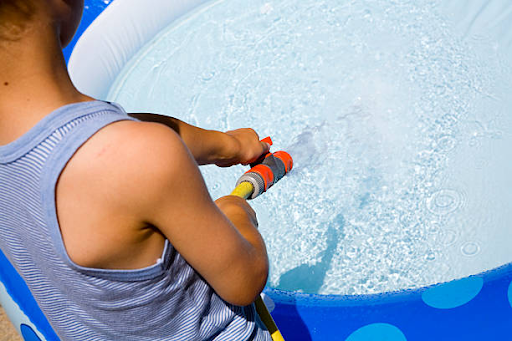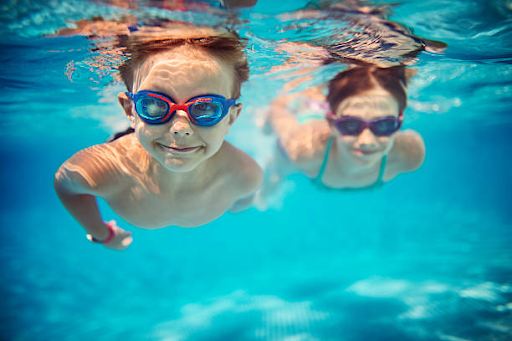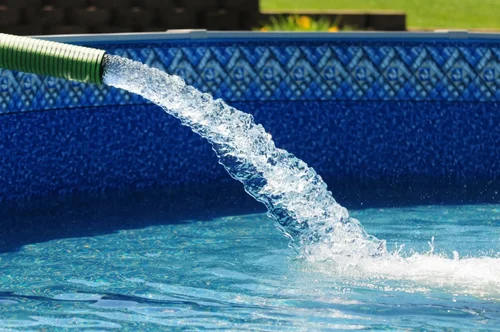Like many others, you might be thinking, “Well, I just filled pool with water, now what?”. It’s great to fill a new pool, but the swimmers are still not safe. To make the pool safe, you must use certain starter chemicals. If this is something you have never done before, treating pool water could seem intimidating. It would help if you did a few things to ensure your pool is swimmer-safe before you plunge in. We consulted specialists in pool maintenance and the Centers for Disease Control and Prevention (CDC) to assist you in finding out just how to proceed.

How Do You Put Chemicals in the Pool for the First Time
The greatest thing you can do is be ready, whether you’re a first-time pool owner or your pool is waking up from a long winter nap. How do you prepare, then? Therefore, the first step would be to be aware of the chemical levels to observe and how frequently they need to be addressed. Your water testing kits, or strips are the most important item to have on hand, according to any experienced pool owner.
What Is the First Chemical You Put in a Pool
The first chemical you should put into the pool once it has been opened and the walls and floor have been brushed up is chlorine to shock it. For every 5,000 gallons of pool water, it is advised that you add one gallon of liquid chlorine or one pound of granular chlorine. After the opening procedure, you can also add extra chlorine.

How To Balance Pool Water After Refilling
Follow this guide if you want to add chemicals and balance pool water after refilling.
EVALUATE AND CHANGE TOTAL ALKALINITY:
The first item you should balance in your pool’s water is total alkalinity (TA). The alkaline content of the water is indicated by the abbreviation TA. Additionally, the number of alkaline compounds in water will impact the pH balance since alkaline is a pH stabilizer. Pool water should have total alkalinity between 80 and 120 ppm. You can add up to 25 pounds of sodium bicarbonate (baking soda) per 10,000 gallons (about 37854.1 L) of pool water if you need to raise the total alkalinity. Add muriatic acid or sodium bicarbonate to lower the total alkalinity (dry acid).
TEST AND PH ADJUST:
The pH of a material indicates how basic or acidic it is and ranges from 1.0 to 14.0, with 0.0 to 7.0 being basic and 7.0 to 14.0 being acidic. To prevent damage to your pool, it’s essential to maintain a stable pH level. 7.4 to 7.6 is the optimal pH range for pool water. Add a pH increaser, such as sodium carbonate (soda ash), to raise pH levels; 6 ounces (about 177.44 ml) of soda ash will elevate a 10,000-gallon pool’s pH level by 0.2. The Total Alkalinity may be too low if your pH varies. If so, add baking soda to the solution to raise the alkalinity and maintain the pH.
ESTIMATE AND CHANGE CALCIUM HARDNESS:
If calcium builds up in your pool’s water, you can start to see a white line (scale) appearing around your water line. This scale development can harm your pool’s materials and equipment and make it appear unclean. 200 to 400 ppm of calcium hardness is considered optimum. Add calcium chloride to your pool as directed on the label if you need to boost the calcium hardness. If necessary, drain part of your pool and replenish it with new water to lower the calcium hardness. Additionally, use flocculants to gather extra calcium and a pool vacuum to remove it.
YOUR WATER SHOULD BE SANITIZED:
The sanitizer will keep your pool tidy and microbially free, so the water is safe for swimming. The most popular sanitizer used in swimming pools is chlorine.
VERIFY AND ADJUST NATURAL ACID:
Cyanuric acid (CYA) stops sunlight from destroying chlorine in swimming pool water. Although CYA is frequently present in pool shock, you might need to add additional to ensure it adequately preserves the chlorine in your pool. 30 to 50 ppm of cyanuric acid is the recommended range for pool water.
TAKE MEASURE OF ALL DISSOLVED SOLIDS IN YOUR WATER:
Total Dissolved Solids (TDS) is a term used to describe the variety of pollutants, such as chemicals, algaecides, shock, salts, and other contaminants, that have dissolved in your swimming pool water. TDS may be present in pools at levels up to around 1,000 without becoming unacceptably excessive. However, there is a limit. You don’t need to modify the water if the TDS level in your pool is less than 2,000. However, if the TDS level in your pool exceeds 2,000, you will need to drain tiny quantities of water from the pool and replace it with fresh water. Continue testing until the TDS level falls below 2,000.

Should I Shock My Pool After Filling It?
By being shocked, your pool’s water is cleaned, sanitized, and safe to use.
Pool shock treatment:
- 5-gallon bucket full of warm water
- Mix a pound of pool shock into the water in the bucket gradually.
- When the shock is gone, stir with a stick.
- Pour the bucket of shock water into the pool gently as you circle it, concentrating on the deep end.
At least six hours after shocking the pool, test the water and make any required modifications using the instructions above.
How Soon After Filling a Pool Can You Swim?
Wait around 24 hours or until levels reach 5 ppm before adding chlorine or non-chlorine chemicals to “shock” your pool following a fill-up. It is often safe to swim after 4 hours or until levels are 5 ppm or below if you merely apply liquid chlorine. Generally speaking, you should give the pool at least four hours to dry out after adding liquid chlorine. This is also influenced by the size of your pool and the quantity of chlorine applied. You can swim after your levels are 5 ppm or below.

Conclusion:
The water’s temperature will impact the efficiency of pool chemicals. You might need to use fewer chemicals to balance the water at higher degrees since the water and chemicals are more active at such temperatures. Additionally, you might need to add extra chemicals to balance the water at lower temperatures. This guide has covered everything: just filled pool with water, Now what? Now let’s get ready for swimming.
